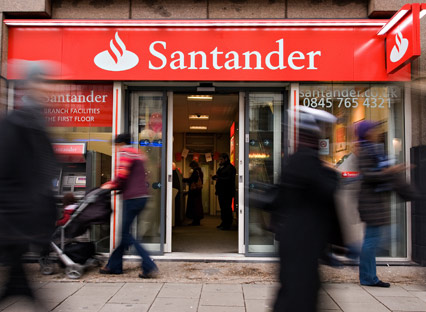Where should you put your cash after latest interest rate cuts?
Santander, Lloyds Club and Nationwide offering best rates on savings - but riskier peer-to-peer pays much more

Savers were struck another blow last week with banks and building societies taking an axe to the high interest rates and rewards offered on some current accounts.
Santander, Lloyds, TSB and Halifax have now all announced that they are going to cut the money paid out to their current account customers.
The first cut comes in two weeks time when Santander halves the rate on its 123 current account. At present customers with more than £3,000 in their account enjoy a three per cent interest rate, while those with £2,000 to £2,999 get two per cent and those with up to £2,000 get one per cent interest.
The Week
Escape your echo chamber. Get the facts behind the news, plus analysis from multiple perspectives.

Sign up for The Week's Free Newsletters
From our morning news briefing to a weekly Good News Newsletter, get the best of The Week delivered directly to your inbox.
From our morning news briefing to a weekly Good News Newsletter, get the best of The Week delivered directly to your inbox.
But, from November everyone earns 1.5 per cent regardless of their balance.
Next up is TSB, which is cutting the interest rate on its Classic Plus current account from five per cent to three per cent from 4 January. You will also only get the interest on balances up to £1,500, down from £2,000.
Then on 8 January the rate on the Lloyds Club current account halves from four per cent to two per cent. But, it will still be paid on balances up to £5,000.
Finally, on 1 February the Halifax Reward account will cut its monthly payout to customers from £5 to £3.
A free daily email with the biggest news stories of the day – and the best features from TheWeek.com
It’s bleak news for savers scrabbling for accounts that offer real growth in the current ultra low-rates environment, but it isn’t a huge surprise. With savings rates getting cut left, right and centre it was only a matter of time before banks and building societies cut the rates on their current accounts too.
So, should you move your cash into savings? That depends on the size of your nest egg.
Santander’s 123 account starts to lose its appeal as a savings option with its rate cut. That’s because the account also charges a £5 monthly fee. If you have more than £10,000 you may want to stick with it: a £20,000 balance is still earning the equivalent of 1.2 per cent after the monthly fee is taken off – you can’t beat that for that larger balance elsewhere.
But, if you have £5,000 to £10,000 you should move to a traditional savings account as, after the fee, a traditional savings account paying you per cent interest – offered by ICICI Bank, RSI Bank and NS&I amongst others – is more rewarding.
If you have £2,500 to £5,000 then the Lloyds Club current account offers the best interest on the market even at two per cent. Just be aware you have to credit the account with £1,500 a month otherwise there is a £5 monthly fee.
Anyone with less than £2,500 should turn to Nationwide as, for now, it is still paying five per cent interest on its FlexDirect account on balances up to £2,500. But, it may follow its rivals and cut its rate.
Another option, if you are prepared to take a bit more risk with your cash, is to lend you savings via a peer-to-peer lender.
The rates here are far higher, but your money isn’t covered by the Financial Services Compensation Scheme. This means if the lender goes bust you could lose your savings. You also risk your borrowers defaulting – although the big names have safety net funds in place to pay out if that happens.
Zopa is offering returns of up to 6.5 per cent and Ratesetter five per cent.
Lloyds, Halifax and TSB latest to slash interest rates
12 October
Lloyds, Halifax and TSB have become the latest high street banks hitting savers with sharp cuts to interest rates.
The top rate on the popular Club Lloyds current account has been halved from four per cent to two per cent. TSB has similarly slashed the rate on its top-paying Classic Plus account from five per cent to three per cent.
Lloyds's sister bank Halifax is also cutting the monthly payments to those paying at least £1,000 a month into its Reward current account, from £5 to £3.
The moves follow the halving by Santander of the top rate on its 123 account. It had topped best-buy tables for years with its three per cent on balances up to £20,000.
Earlier this month, HSBC, its First Direct subsidiary and M&S Bank all cut the interest rates on their regular savings accounts from six per cent to five per cent.
Lloyds said in August that rates were under review thanks to "changing market conditions", says the Daily Mail, not least the base interest rate being cut to a new record low of 0.25 per cent.
The changes come into effect in January, after which Club Lloyds will pay a flat rate of two per cent on balances between £1 and £5,000.
It had previously paid one per cent between £1,000 and £2,000 and two per cent between £2,000 and £4,000, so for customers with balances up to this level, rates will either improve or remain the same.
But it had attracted substantial transfers in recent years because of its headline four per cent rate on balances between £4,000 and £5,000. Annual interest for those with the maximum amount will now be capped at £101, down from £204.
The annual fee will fall from £5 to £3 and will continue to be waived for those paying in £1,500 a month.
TSB's account paid five per cent on balances up to £2,000. It will now not only offer the lower rate of three per cent, it will only apply to balances of up to £1,500.
However, it's getting harder and harder for savers to find a decent rate of return on cash and these accounts will remain attractive for many.
The Daily Telegraph says that for smaller balances, Nationwide's five per cent rate on its FlexDirect current account is still eye-catching. It is, however, only available for 12 months, after which it falls to one per cent.
Should you ditch your Santander 123 account after rates cut?
18 August
Santander is halving the interest rate paid on its popular 123 Current Account.
At present account holders with between £3,000 and £20,000 in savings earn three per cent interest but, following the Bank of England’s decision to cut the base rate, Santander is cutting the interest rate on the account down to 1.5 per cent.
In the past the 123 account paid differing interest rates depending on your account balance - starting at one per cent between £1,000 and £2,000 and rising to two per cent between £2,000 and £3,000 - but now it will be a flat 1.5 per cent for everyone.
This means some customers with small balances will actually see their interest rate go up, but not by much and only on small savings pots on which better rates are still available elsewhere.
So should you leave?
The interest rate cut may make the account less attractive, but customers shouldn’t beat a path to the door just yet. The account is still paying a very competitive rate for an instant access account.
The best buy easy access savings account is offered by RCI Bank and pays 1.2 per cent. Santander’s rate may seem better on the surface, but once you factor in the £5 a month fee for the 123 account you would need to have a lot of money on deposit to match RCI Bank’s offer.
Both would pay £240 interest annually on a £20,000 balance after charges. If you have £10,000 you would earn £120 from RCI Bank, but only £90 from Santander after charges.
However, if you use your Santander account to pay your bills you would also benefit from a range of cashback that could cover the fee - and may boost your returns beyond that as well.
You’ll earn one per cent cashback on water and council tax bills and Santander mortgage payments, two per cent on energy bills and three per cent on phone, broadband and TV bills. You can use Santander’s calculator to see how much you would earn.
Blogger Martin Lewis reckons many people earn as much as £500 a year, if they use the account for all of their bills .
For the best risk-free cash returns current accounts are still the way to go. If you only have a small balance then you can still get a much better interest rate from TSB and Nationwide, who pay five per cent on current account balances of up to £2,000 and £2,500 respectively.
But, those rates may not last much longer.
“Clearly the economics no longer stacked up for Santander, but with the base rate teetering towards zero it may not be the last bank to trim its in credit current account rate,” Andrew Hagger of Moneycomms.co.uk, told the BBC.
For now, the advice is that Santander account holders with balances above the cut off for Nationwide or TSB’s five per cent accounts should stay put, at least until the rate cut takes place in November.
For those with a big balance getting towards the £20,000 limit, and who earn hefty cashback including on their linked Santander mortgage, the numbers might still be in the Spanish bank's favour even after that.
Will Lloyds, TSB or Tesco follow Santander 123 cut?
16 August
Santander's announcement that it is slashing the rate of interest it pays on its hugely popular 123 current account has shocked savers.
It is not so much that a cut was made – that had been widely predicted - it was the scale of the drop, from three per cent on balances up to £20,000 to 1.5 per cent from 1 November.
Personal finance writer Martin Lewis has told savers who may "be furious and want to ditch it to punish Santander" to "wait to see how the land lies" before the reduction comes into effect.
In the current ultra-low interest rate environment, Santander may just "be at the vanguard of rate cuts", he says.
At the moment, a host of accounts rival Santander at the new rates, including the four per cent on offer from Club Lloyds up to £5,000, the five per cent available through TSB up to £2,000 and the three per cent on up £3,000 from Tesco.
Nationwide also has a high-paying account offering five per cent up to £2,500, but only for the first 12 months.
The problem is, as Santander found, when rates across the sector tumble, banks and building societies can find themselves far ahead at the top of the best-buy tables and be swamped with such a flood of cash that these deals become prohibitively expensive.
Lenders are also seeing their general underlying profit margins squeezed in the wake of the latest base rate cut to 0.25 per cent – and the expectation this will fall closer to zero in the months ahead.
Lloyds has already signalled a cut on the Club Lloyds account could be coming down the line, with a spokesman telling the Financial Times that because of "market conditions", the bank would be "reviewing our current accounts in due course".
Even if no other rates are chopped, says Lewis, Santander would remain the best option for some because it pays out its interest on larger balances.
It the cashback available on bills covers the £5 monthly fee, the Santander 123 account at the lower rate would come top for anyone with £13,200 or more in savings, he adds. Without the £60 annual fee being covered, it is out in front for those with £15,000.
That would be worse than the position now, says Lewis, when even with no cashback, the account stands out for anyone with around £8,000.
Santander 123 interest slashed in half in latest blow for savers
15 August
Santander has slashed the interest rate on its popular 123 current account to half of its current level.
Currently, 123 account holders get three per cent on balances between £3,000 and £20,000 – a rate that, with Isa rates hovering around one per cent, has been described as a last "refuge" for savers by MoneySavingExpert's Martin Lewis.
However, from November, the interest will drop to 1.5 per cent, reports the Financial Times.
The bank blamed the reduction on the Bank of England's cut in the base interest rate to 0.25 per cent following the UK's vote for Brexit, which could be moved even closer to zero and remain lower for longer than previously anticipated.
Santander's 1.5 per cent drop is, however, well in excess of the 0.25 per cent reduction and continues a trend of banks and building societies going much further than the Bank of England to combat a squeeze on profit margins.
First Direct will cut its cash Isa rate by 0.4 per cent from October, while smaller lenders such as Marsden and Skipton are making similar moves or pulling top-paying products altogether.
Like those smaller players, Santander points to its stand-out status as the reason for its Bank of England-busting rates chop, which has resulted in it pulling in huge sums of deposits on which the high-payout rate represents an ever-larger hit.
A spokesman for the bank told the FT it has signed up 279,000 people in the first half of 2016 despite an increase in the monthly fee from £2 to £5 last November.
Speaking to the Guardian, MoneySavingExpert's Lewis said many customers "will be furious and want to ditch [their 123 account] to punish Santander", although he warned it may make sense for some to hold on.
There are other top-paying products, most of which are now current accounts, that can beat Santander, but mostly only on lower balances.
Club Lloyds members can get four per cent on balances between £4,000 and £5,000 if a regular £1,500 is deposited each month. TSB pays five per cent on balances up to £2,000 with a £500 monthly deposit and Tesco pays three per cent on balances up to £3,000, with no conditions.
Nationwide pays five per cent on balances up to £2,500 with a £1,000 monthly deposit, but only for the first year. It vowed in half-year results today to protect this and other rates for regular savers, reports Sky News.
-
 Venezuela’s Trump-shaped power vacuum
Venezuela’s Trump-shaped power vacuumIN THE SPOTLIGHT The American abduction of Venezuelan President Nicolás Maduro has thrust South America’s biggest oil-producing state into uncharted geopolitical waters
-
 Most data centers are being built in the wrong climate
Most data centers are being built in the wrong climateThe explainer Data centers require substantial water and energy. But certain locations are more strained than others, mainly due to rising temperatures.
-
 ‘Maps are the ideal metaphor for our models of what the world might be’
‘Maps are the ideal metaphor for our models of what the world might be’Instant Opinion Opinion, comment and editorials of the day
-
 Brits keeping 21 million ‘money secrets’ from friends and family, survey reveals
Brits keeping 21 million ‘money secrets’ from friends and family, survey revealsSpeed Read Four in ten people admit staying quiet or telling fibs about debts or savings
-
 London renters swap cramped flats for space in suburbia
London renters swap cramped flats for space in suburbiaSpeed Read New figures show tenants are leaving Britain's cities and looking to upsize
-
 Should the mortgage holiday scheme have been extended?
Should the mortgage holiday scheme have been extended?Speed Read Banks warn that some homeowners may struggle to repay additional debt
-
 RBS offers coronavirus mortgage holidays
RBS offers coronavirus mortgage holidaysSpeed Read Taxpayer-owned bank follows measures taken in virus-struck Italy
-
 What are the changes to National Savings payouts?
What are the changes to National Savings payouts?Speed Read National Savings & Investments cuts dividends and prizes for bonds
-
 China clears path to new digital currency
China clears path to new digital currencySpeed Read Unlike other cryptocurrencies, Beijing’s would increase central control of the financial system
-
 Why are donations surging to the RNLI?
Why are donations surging to the RNLI?Speed Read Charity enjoys flood of funding after criticism for overseas work
-
 PPI deadline day: how to claim
PPI deadline day: how to claimSpeed Read Final chance for consumers to apply for compensation